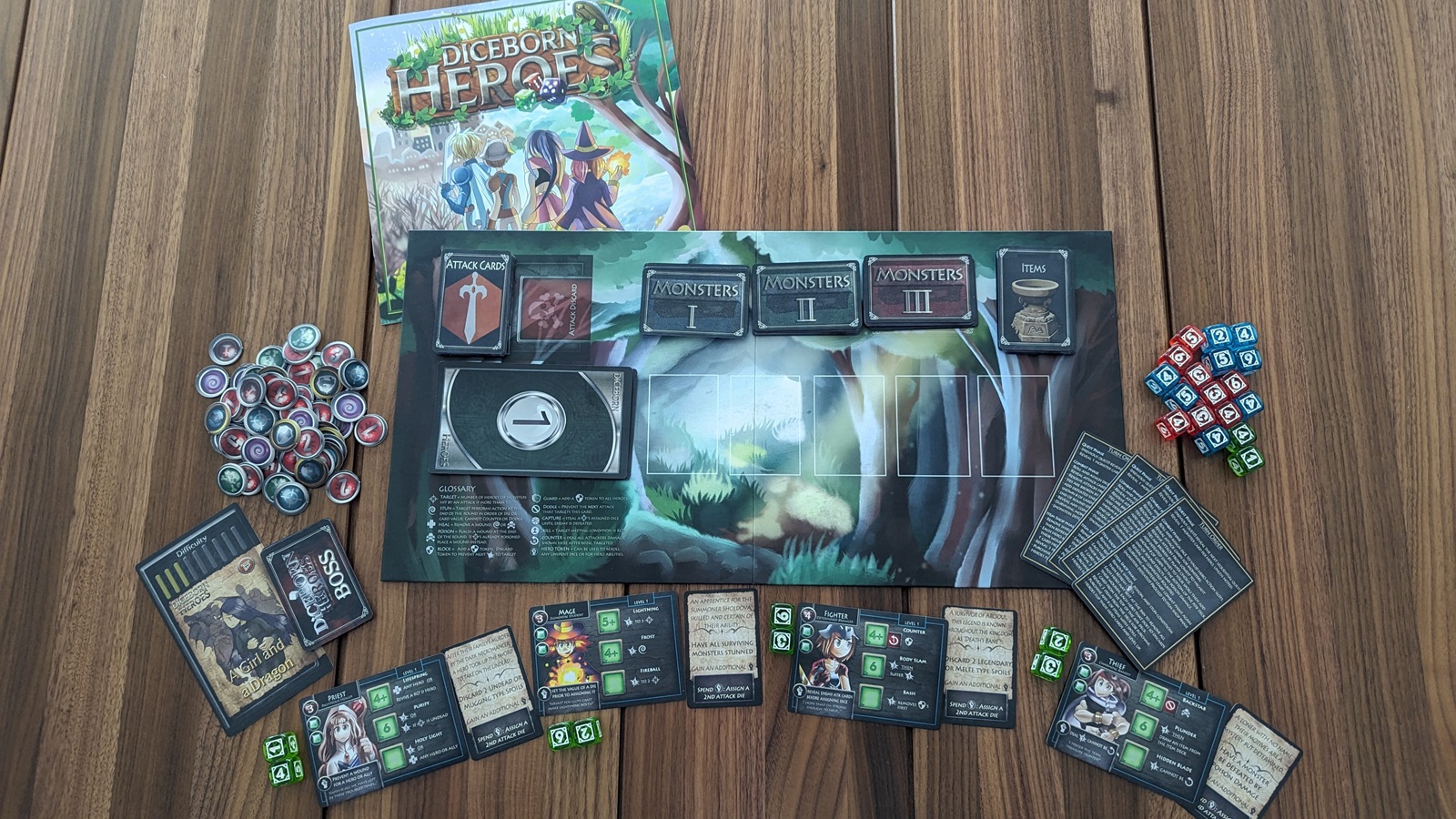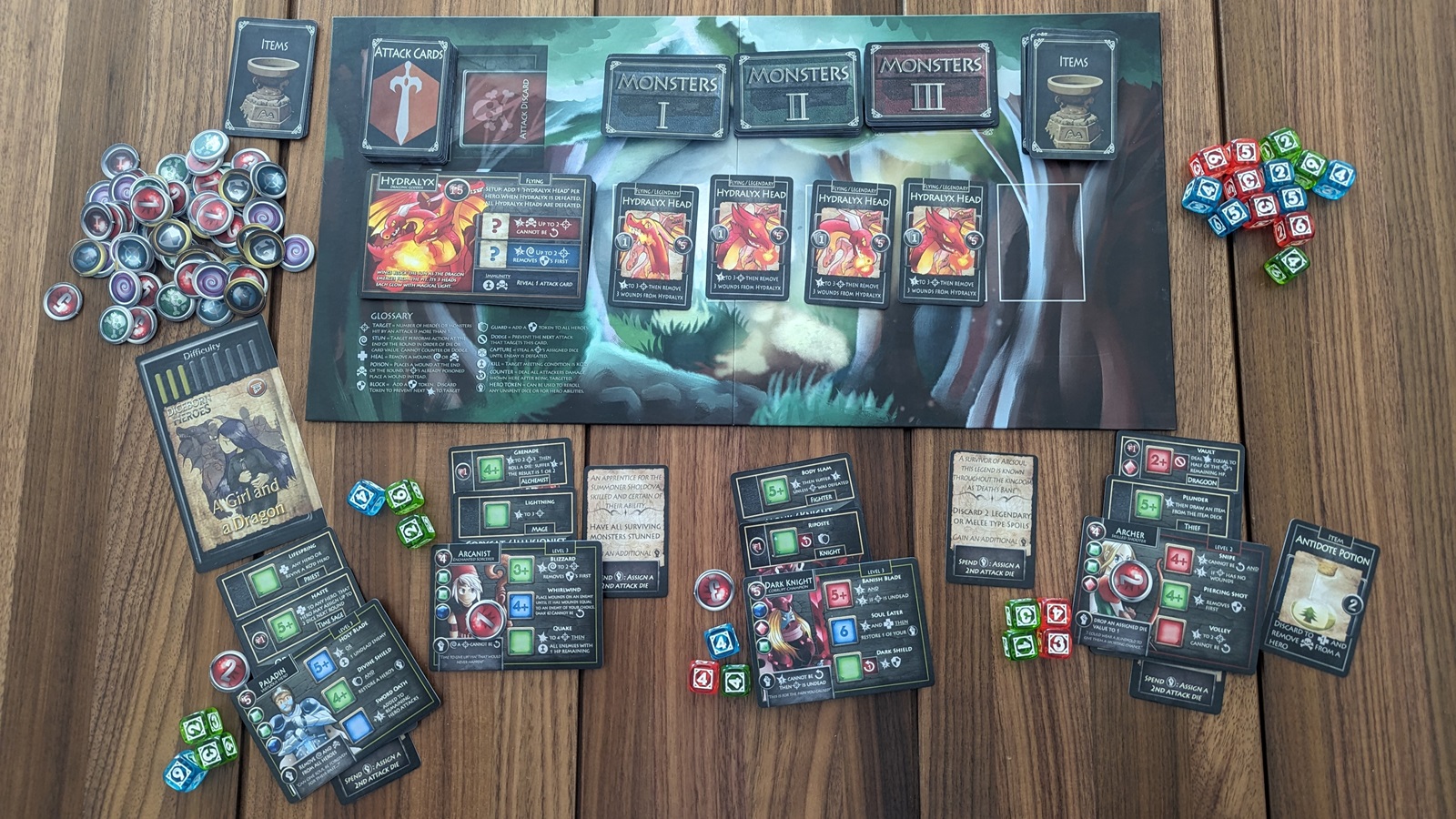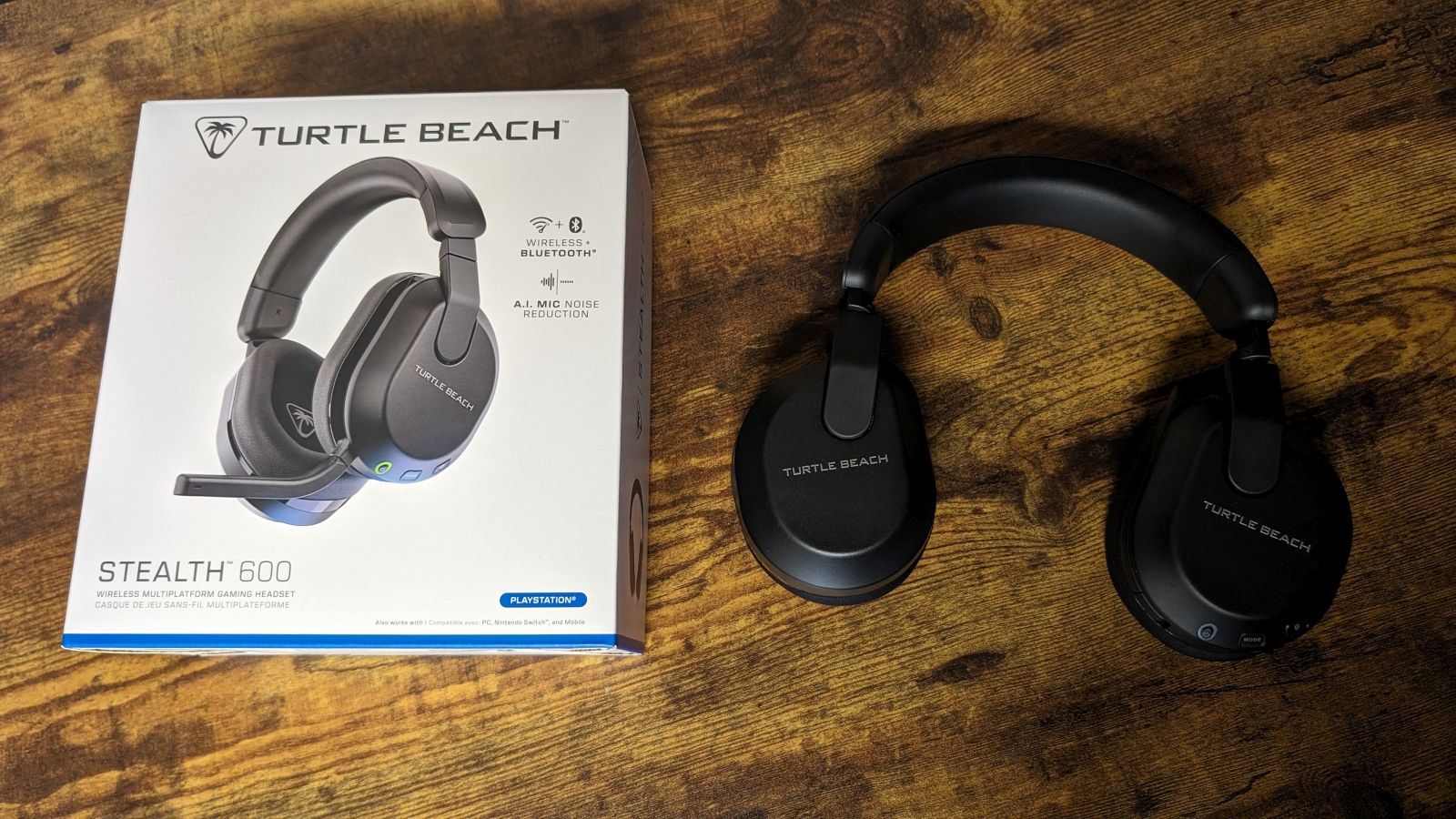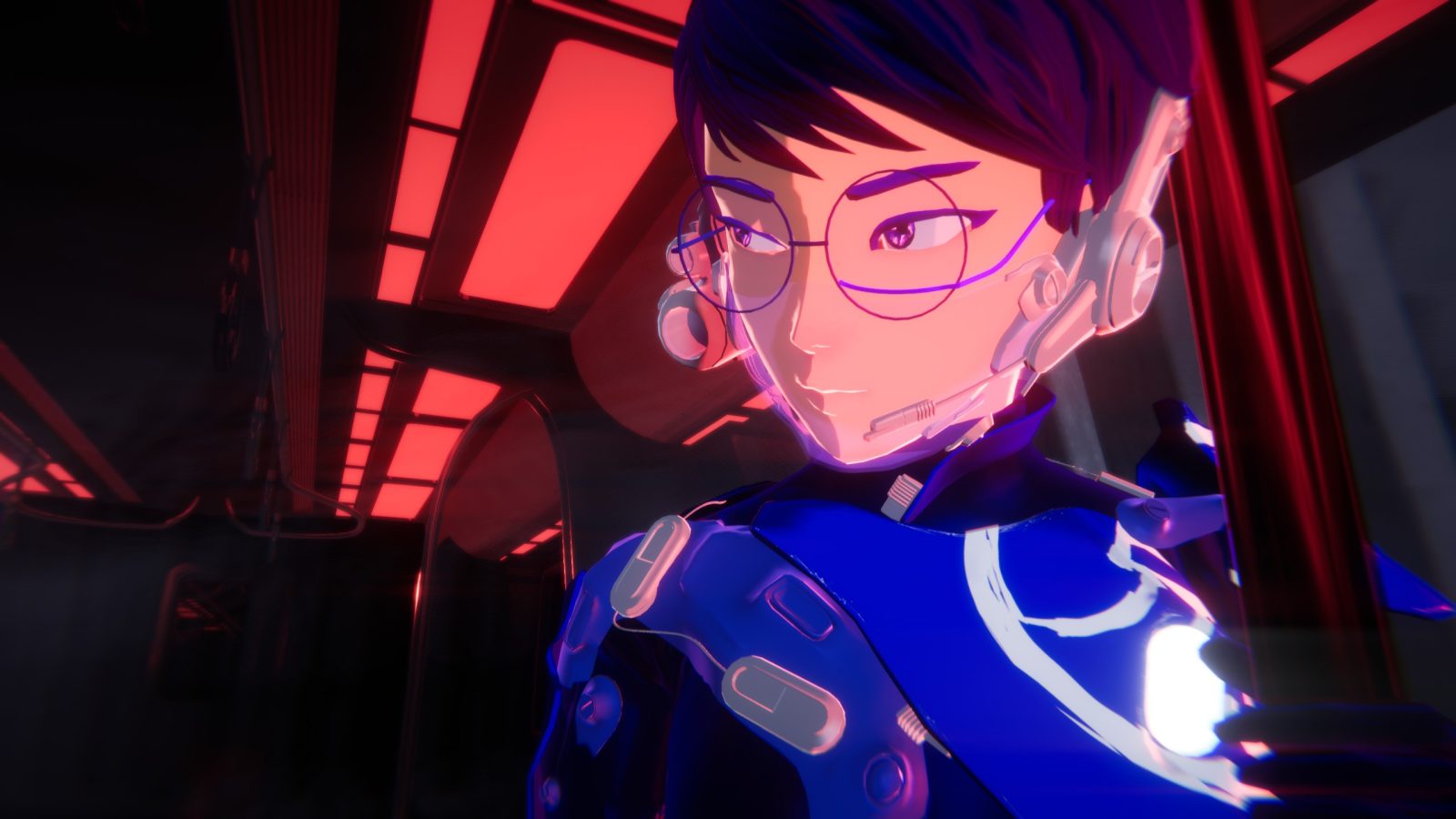At the beginning of the rulebook, Diceborn Heroes introduces itself as a cooperative fantasy dice game inspired by “old school JRPGs.” As I began exploring the vibrant box of cardboard I found this to be an intriguing introduction. I am old enough to remember the ye olde days of the 2D JRPG games so I wondered if this claim would hold up. This thought stayed with me as I played Diceborn Heroes. So, as the game says, it’s a one to four player cooperative dice game where the players take the role of heroes who band together to save the day. Let’s examine how the game plays and if that claim from the rulebook’s introduction is true.
Overview
Players begin with one of the base hero classes: Fighter, Priest, Mage, or Thief and are challenged to fight through a quest pack in order to reach the final boss. If the players defeat the final boss, they win that quest pack. Each quest pack has three levels: I, II, and III. At the beginning of each level the players flip the next quest card which has a bit of story and special conditions to add to that level of the quest. Then the players (usually) add one monster of that level for each player into the combat. Once any special conditions on the quest have been met and all the monsters defeated; the players have beaten that level of the quest.

Diceborn Heroes setup for four players
Defeating the monsters is played out in rounds of combat, and each round the players will roll their dice and can assign one of these dice to activate one of their abilities. The various classes have different abilities with different number or color requirements. Players can only assign a die to that ability if they meet the number and color requirements and the more powerful abilities require high numbers to activate. After the players have assigned their dice each monster will draw an attack card from the attack deck. This card assigns the monster an attack value from one to six. Heroes and monsters resolve their attacks starting with the lowest numbers going up with the players deciding the order on any ties. A monster will only attack a player(s) that has assigned a die of equal or higher value starting with the closest numbers. This creates an interesting risk/reward every round as players can activate abilities with low value dice that aren’t as powerful, but they are less likely to be attacked. It is even possible that a monster doesn’t attack anyone because it doesn’t have a valid target. Do you want to activate your more powerful abilities at an increased risk of being attacked? Another consideration is that the heroes lose the game should the attack deck ever run out of cards. This creates a timer that prevents the heroes from simply using their lower power abilities to try and avoid attacks each round. After a monster is defeated the heroes add a specific number of cards back into the attack deck extending that timer. If a hero ever takes wounds equal to their health they are knocked out, but in future rounds if they roll any doubles on their dice that hero will wake up at one HP and act that round.
Once a level has been completed the heroes are offered the choice to rest which fully heals a hero (it even revives them), but also removes one attack card from the attack deck. The heroes may then buy items from the item deck with the previously defeated monsters as their currency. Last, but certainly not least, the heroes get to upgrade their character by either upgrading into a new class or by adding a new class ability to their existing class. You might begin a game as a humble Priest, but you could end as a Paladin or an Arcanist with dramatically different abilities. Then the heroes move on to the next level unless they’ve completed level III where they then immediately face the final boss without a chance to rest. Bosses are unique encounters that may even have multiple phases to the boss itself.

Diceborn Heroes at a final boss
While the core of the game is the combat there are other smaller rules reinforcing the gameplay. Each hero class has a special power that they can use once per level at the cost of their hero token. These abilities vary in power, but are key for the heroes to come out on top. A hero is also given two bounty cards at the start of the game from which they will choose one to keep. If the hero can fulfill the bounty they gain an alternate use of their hero token which allows them to assign a second die to one of their actions. Quests can have small branching effects where the heroes can gain quest specific items or even special attack cards that can help the heroes.
Pros and Cons
The core game of Diceborn Heroes isn’t too complicated as heroes only have two to four dice to roll throughout the game. However, it’s possible to roll in a way where you can only activate one ability so there isn’t any choice on what you can do that round. When that happens it’s not interesting as there is no decision to make that round. There are even game effects that can cost the heroes a die further limiting the possible actions that player could take. This is my biggest criticism of the game. I wish that there was more luck mitigation throughout the game as players are dependent on their rolls for the actions they take. This is relatively balanced out by the fact that Diceborn Heroes isn’t very long. Most of the games I played took about an hour and if the heroes failed it was incredibly easy to reset the game and try again.

Two examples of fully leveled up characters. The Archer has completed their bounty card.
Diceborn Heroes doesn’t have a campaign which keeps the game easygoing and lighthearted. The quests are varied enough to provide different experiences and challenges. Alongside that the classes branch off into new and more interesting classes. This does leave the first battle with the base classes feeling somewhat anemic as the starting classes aren’t very powerful and only have two dice. One of the game’s biggest strengths is in leveling up your hero into something new and different. You can either take a new class and keep on ability from your old class or you can keep your current class and take an ability from the new class. I really like the decision of how to customize your hero and by the end of the game even if players started with the same class they are likely going to be quite different by the end of the game.
My other big criticism is that I simply wish there were “more” to the game. What I mean by that is I wish you got to spend more time with your fully leveled hero. This would betray the game’s shorter nature, but by the time I got to the third quest I wanted to keep playing with my fully leveled hero. The rulebook even offers players different ways to play like a boss rush which feels like an inclusion for players who want to create their own challenges. Nothing stops me from continuing to play with my leveled hero other than my lack of imagination.
The way monster attacks resolve to also be one of the best features the game has. This is where the JRPG inspiration comes through the most as the monster actions are always unpredictable as you’re never sure how the monsters will activate. There are rounds where no heroes get attacked at all and others where one hero could go from full health to knocked out. That risk reward in how quickly your hero will activate is fun. This alongside the attack deck being a timer keeps the pressure on the heroes to keep pushing forward into the monsters. When you do have several choices on what to do, that choice can be difficult to make, which is a good thing as it means that choice is important.

Examples of the monster artwork. I don’t know what a Shoo is, but I want one.
The game’s components are quite nice. The dice are high quality with their translucent colors. The main board, tokens, and cards are all good quality and easy to read. The other major inspiration from JRPGs is the game’s artwork. I found the cartoony style artwork charming and fitting for the lightweight nature of Diceborn Heroes. The artwork reflects where I think Diceborn Heroes would shine the most which I think is in a family setting. Kids would benefit from the game’s shorter nature and wouldn’t feel overwhelmed by too many decisions. The copy I reviewed had the Treasure Pack expansion included that added more quests and hero options. Returning to the rulebook’s different ways to play, Diceborn Heroes almost feels like a sandbox for players to create their own adventures and those extra ideas are a welcome addition. Lastly, the Mastermind boss was a nice hidden touch. If you’re not sure what I mean, you’ll have to acquire your own copy of Diceborn Heroes and give it a good search. In the end I do believe that Diceborn Heroes lives up to its claim for its source of inspiration as it does a good job of emulating the old school feel of classic JRPGs.
Chris began tabletop gaming in college and quickly fell into the addictive world of cardboard. Beginning with D&D and Catan he became an enthusiast of all things gaming; analog or digital. Chris, now a recovering MtG player, loves connecting with people via gaming through RPGs, board games, and video games. A particular favorite is testing friendships through social deduction games.

Diceborn Heroes is a lightweight cooperative dice game that emulates the feel and style of JRPGs. While I wish there were more choices from round to round in combat, Diceborn Heroes is a fun adventure anyone can enjoy. The quest packs offer a variety of fun challenges with a range of difficulties. Leveling up your hero is particularly fun and the combat resolution mechanics offer a unique puzzle to solve each round. I can recommend Diceborn Heroes to anyone looking for a cooperative adventure game.
PROS
- Easy to setup and learn
- Monster attack system is unique
- Leveling up characters is fun
CONS
- Not a lot of luck mitigation
- Sometimes a player only has one choice in combat
Unless otherwise stated, the product in this article was provided for review purposes.
See below for our list of partners and affiliates:

 2 months ago
75
2 months ago
75








